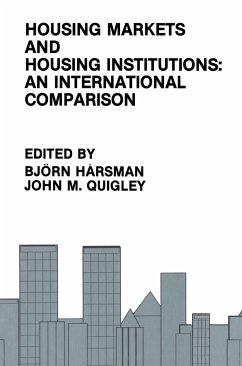International comparisons of economic institutions and government poli cies are fraught with difficulties. After1he selective barriers of language and culture are overcome, differences in programs and outcomes are far more subtle than those that can be revealed by highly aggregated national data. Rela tively "soft" comparisons are the norm in international comparative research. This is particularly true in comparative analyses of housing and the operation of housing markets. Housing markets are local or regional in character, and the effects of government programs on market outcomes depend upon important economic characteristics of the local environment. Moreover, the institutions that influence the production, distribution, and consumption of housing differ enormously across nations. The distribution of housing and the role of the market in provision depend upon historical and social factors as well. Aggregate national data are unlikely to allow for much depth in comparisons across societies. Yet in the absence of such comparisons, the very visibility of housing may lead to inadequate or erroneous generalizations. Photographs emphasing the aesthetics of ''well planned" housing agglomorations or urban slums are compelling. Documen tation that middle-class households must wait in a queue for a decade to be housed is notably less graphic.
'This book represents the first truly comparative economic analysis of housing policy. While the housing policy literature is vast and many comparative books are available, these analyses ... tend to be political/historical studies describing various housing problems and policies, and their evolution over time. These books, however, in general fail to provide an adequate economic analysis of housing policy. The present book represents a distinct improvement in this respect. ' -- Thomas S. Nesslein, Kyklos, November 1993
'This is an extremely useful book for any researcher or teacher in the housing studies area. Its value is that it attempts to unravel how, in various contexts, housing systems actually work. By providing detailed evaluations of the effects of policies at a variety of levels on market outcomes and consumer welfare in specific situations, it contains insights into both the benefits and costs of a variety of interventions. ' -- Chris Mahler, Urban Studies, February 1993
'All chapters are well written with consistent editing, and each is a complete case study. This book is an excellent reference source of housing data for the cities included. ' -- Margaret Miano, The APA Journal, Autumn 1992
'The book is an important source book for researchers who are interested in the historical development of housing policies and who wish to gain a reasonable working knowledge of the operation of a cross section of markets in wealthier countries. ' -- M. Stabler, Regional Studies, 1992
'The case studies are careful, thorough, and informed surveys of housing trends, conditions, and policies in their subject areas. Although they do not follow a common outline, all include the important historical and institutional information. Each presents a detailed history of government housing policies, in most cases covering at least most of the postwar period. ' -- Edwin S. Mills, Journal of Economic Literature, 1994
'It is a welcome sign that serious international comparative housing analysis may finally be coming of age ... After reading this book, we know how seven international housing markets are structured and operate. We understand what caused the failures and successes of these seven housing policies. ' -- Bertrand Renaud, Journal of Housing Economics, 1994
'This is an extremely useful book for any researcher or teacher in the housing studies area. Its value is that it attempts to unravel how, in various contexts, housing systems actually work. By providing detailed evaluations of the effects of policies at a variety of levels on market outcomes and consumer welfare in specific situations, it contains insights into both the benefits and costs of a variety of interventions. ' -- Chris Mahler, Urban Studies, February 1993
'All chapters are well written with consistent editing, and each is a complete case study. This book is an excellent reference source of housing data for the cities included. ' -- Margaret Miano, The APA Journal, Autumn 1992
'The book is an important source book for researchers who are interested in the historical development of housing policies and who wish to gain a reasonable working knowledge of the operation of a cross section of markets in wealthier countries. ' -- M. Stabler, Regional Studies, 1992
'The case studies are careful, thorough, and informed surveys of housing trends, conditions, and policies in their subject areas. Although they do not follow a common outline, all include the important historical and institutional information. Each presents a detailed history of government housing policies, in most cases covering at least most of the postwar period. ' -- Edwin S. Mills, Journal of Economic Literature, 1994
'It is a welcome sign that serious international comparative housing analysis may finally be coming of age ... After reading this book, we know how seven international housing markets are structured and operate. We understand what caused the failures and successes of these seven housing policies. ' -- Bertrand Renaud, Journal of Housing Economics, 1994
`This book represents the first truly comparative economic analysis of housing policy. While the housing policy literature is vast and many comparative books are available, these analyses ... tend to be political/historical studies describing various housing problems and policies, and their evolution over time. These books, however, in general fail to provide an adequate economic analysis of housing policy. The present book represents a distinct improvement in this respect. '
Thomas S. Nesslein, Kyklos, November 1993
`This is an extremely useful book for any researcher or teacher in the housing studies area. Its value is that it attempts to unravel how, in various contexts, housing systems actually work. By providing detailed evaluations of the effects of policies at a variety of levels on market outcomes and consumer welfare in specific situations, it contains insights into both the benefits and costs of a variety of interventions. '
Chris Mahler, Urban Studies, February 1993
`All chapters are well written with consistent editing, and each is a complete case study. This book is an excellent reference source of housing data for the cities included. '
Margaret Miano, The APA Journal, Autumn 1992
`The book is an important source book for researchers who are interested in the historical development of housing policies and who wish to gain a reasonable working knowledge of the operation of a cross section of markets in wealthier countries. '
M. Stabler, Regional Studies, 1992
`The case studies are careful, thorough, and informed surveys of housing trends, conditions, and policies in their subject areas. Although they do not follow a common outline, all include the important historical and institutional information. Each presents a detailed history of government housing policies, in most cases covering at least most of the postwar period. '
Edwin S. Mills, Journal of Economic Literature, 1994
`It is a welcome sign that serious international comparative housing analysis may finally be coming of age ... After reading this book, we know how seven international housing markets are structured and operate. We understand what caused the failures and successes of these seven housing policies. '
Bertrand Renaud, Journal of Housing Economics, 1994
Thomas S. Nesslein, Kyklos, November 1993
`This is an extremely useful book for any researcher or teacher in the housing studies area. Its value is that it attempts to unravel how, in various contexts, housing systems actually work. By providing detailed evaluations of the effects of policies at a variety of levels on market outcomes and consumer welfare in specific situations, it contains insights into both the benefits and costs of a variety of interventions. '
Chris Mahler, Urban Studies, February 1993
`All chapters are well written with consistent editing, and each is a complete case study. This book is an excellent reference source of housing data for the cities included. '
Margaret Miano, The APA Journal, Autumn 1992
`The book is an important source book for researchers who are interested in the historical development of housing policies and who wish to gain a reasonable working knowledge of the operation of a cross section of markets in wealthier countries. '
M. Stabler, Regional Studies, 1992
`The case studies are careful, thorough, and informed surveys of housing trends, conditions, and policies in their subject areas. Although they do not follow a common outline, all include the important historical and institutional information. Each presents a detailed history of government housing policies, in most cases covering at least most of the postwar period. '
Edwin S. Mills, Journal of Economic Literature, 1994
`It is a welcome sign that serious international comparative housing analysis may finally be coming of age ... After reading this book, we know how seven international housing markets are structured and operate. We understand what caused the failures and successes of these seven housing policies. '
Bertrand Renaud, Journal of Housing Economics, 1994








